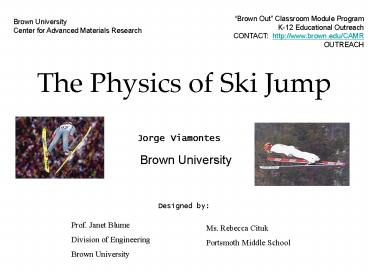The Physics of Ski Jump - PowerPoint PPT Presentation
1 / 12
Title:
The Physics of Ski Jump
Description:
The Physics of Ski Jump. Jorge Viamontes. Designed by: Prof. Janet Blume. Division of Engineering ... What is a ski jump? http://www.huikuri.com/games/skijump ... – PowerPoint PPT presentation
Number of Views:651
Avg rating:3.0/5.0
Title: The Physics of Ski Jump
1
Brown Out Classroom Module Program K-12
Educational Outreach CONTACT http//www.brown.ed
u/CAMR OUTREACH
Brown University Center for Advanced Materials
Research
The Physics of Ski Jump
Jorge Viamontes
Brown University
Designed by
Prof. Janet Blume Division of Engineering Brown
University
Ms. Rebecca Cituk Portsmoth Middle School
2
What is a ski jump?
http//www.huikuri.com/games/skijump/
3
What Do Ski Jumps have to do with Math
Science???
- Gravity
- Drag
- Friction
- Launch Angle
4
GRAVITY
- "Gravity is the force that pulls you down."
- Gravity is one of the universal forces of nature.
It is an attractive force between all matter, and
is very weak as compared to the other forces of
nature. The gravitational force between two
objects is dependent on their masses, which is
why we can only see gravity in action when at
least one of the objects is very large (like the
Earth). - Isaac Newton was the first scientist to define
gravity mathematically when he formulated his law
of universal gravitation. The law of gravitation
says that gravity is strongest between two very
massive objects, and gets much weaker as these
objects get further apart.
Gravity
5
Drag
DragDrag is an aerodynamic force that resists
the motion of an object moving through a fluid
(air and water are both fluids). If you stick
your hand out of a car window while moving, you
will experience a very simple demonstration of
this effect. The amount of drag that your hand
creates depends on a few factors, such as the
size of your hand, the speed of the car and the
density of the air. If you were to slow down, you
would notice that the drag on your hand would
decrease. http//travel.howstuffworks.com/airplane
1.htm
Drag
6
How can we reduce drag?
We see another example of drag reduction when we
watch downhill skiers in the Olympics. You'll
notice that, whenever they get the chance, they
will squeeze down into a tight crouch. By making
themselves "smaller," they decrease the drag they
create, which allows them to move faster down the
hill. (http//travel.howstuffworks.com/airplane1.h
tm)
7
Friction
Friction is the resistance met when one object
moves over or rubs against the surface of
another. The force of friction can start things
moving, slow them down, or even stop them. Two
things that affect the amount of friction
generated are the roughness of the surface and
the weight of the object. http//pd.l2l.org/succes
s/lessons/Lesson11/ISCc4_L.HTM
friction
8
Launch Angle
What goes up must come down goes the old saying.
When a skier goes off the edge of the ski jump
there are various factors that determine how far
away the skier will come down. The launch angle
together with the launch speed determines the
distance the skier can cover through the air.
What is an angle?
Angle between directions given in units of degrees
9
The Experiment
10
Computer Calculation
Using the excel spread sheet below type in the
measurements for Launch Point Y and the Launch
Angle. Record the Land Point x results on the
Olympic Score Sheet. Note The Land Point is
called the Estimated Land Point on the score
sheet.
11
Lets make our own ski jump
launch angle
ramp
Land point x
12
Lab sheet for each group
launch angle __________(degrees) computer
calculated land point x_____________
(meters) experimental land point
x_____________ (meters) Sources of
error 1. 2. 3.































